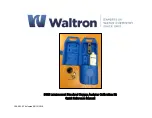
Navigator 600 Silica
Single-stream
3 Principle of Operation
10
IM/NAV6S/SS–EN Rev. E
3.2 Liquid Handling
Referring to Fig. 3.2:
The sample enters the analyzer via a constant head unit
1
situated at the bottom of the analyzer. The constant head unit is
fitted with an 'Out of Sample' switch that detects a loss of
sample. If there is no sample to the analyzer, an automatic
shutdown procedure (see Section 3.3, page 12) is initiated.
Once the sample returns the analyzer restarts automatically.
The sample is drawn up from the constant head unit by the
peristaltic pump
2
via a sample filter that protects the liquid
handling section from blockages caused by any particulates in
the sample.
The sample passes through the clean and secondary calibration
valves before entering a pre-heater coil
3
that heats the
sample to encourage dissolved air in the sample to form
bubbles. These bubbles are removed by the primary debubbler
4
and pumped to drain by the de-gassing channel on the
peristaltic pump. This is necessary to reduce the effect of
bubbles in the sample causing variable reagent mixing, resulting
in noisy readings.
The sample then passes through the zero valve
5
and into the
heated reaction coil
6
where it mixes with the reagents to form
a blue complex (described in detail in Section 3.1, page 8).
The sample exits the reaction coil and passes into the
secondary debubbler assembly
7
which removes any air
bubbles that may emanate from the reagents or further
degassing of the sample. The degassed sample passes
continuously through the measuring cuvette, and then to drain.
Note.
If particulates exceed 60 microns in size, it is
essential to fit external filters to the sample lines prior to
entering the analyzer.













































